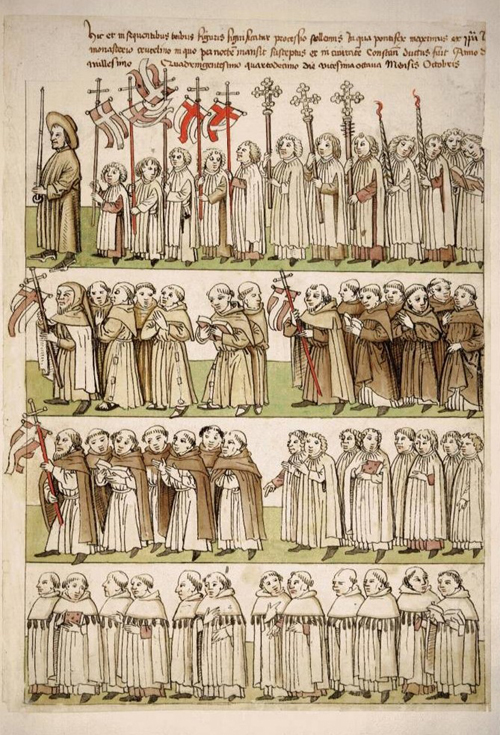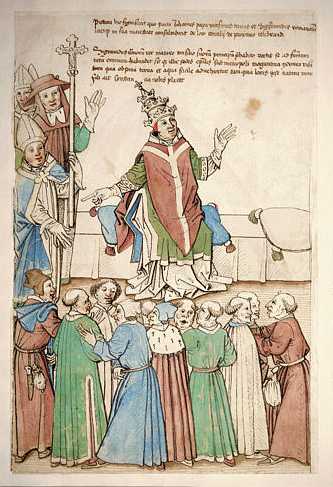 History
102:
History
102:
Western Civilization (II)
The Crisis of Papal Monarchy
Image: a procession of clergymen attending the Council
of Constance, from the Chronicle of the Council of Constance by
Ulrich Riechental.
http://www.unesco.org/webworld/mdm/visite/constantin/en/present1.html
Most people know that the unity of western Christianity ended with the
Protestant Reformation of the sixteenth century. From the 1520s on, western
Christianity would be permanently divided between Roman Catholicism and
the various Protestant confessions or denominations—Lutheran, Anglican,
Reformed (or “Calvinist”), and Anabaptist, just to enumerate the oldest
of these.
Less well known is the fact
that prior to the Reformation, the church experienced one of the most profound
and transforming crises in its history—one which in many ways laid the
groundwork for both the Protestant split and the revival of “Counter-Reformation”
Catholicism. This was a crisis of power and authority within the church,
brought on by the legal election of two popes in the year 1378. This division
in the leadership of the church—called the “Great Schism”—would not end
for nearly forty years. Between 1378 and 1417, both popes—the one
residing in Rome, the other in the city of Avignon in southern France—would
claim the obedience of the entire church, and condemn anyone who obeyed
his rival. Out of this impossible situation grew a fundamental challenge
to the authority of popes in general. In their search for a solution to
the Great Schism, leading church intellectuals and officials revived the
ancient theory that a “General Council” of all the leaders of the church
possessed an authority even greater than that of the pope himself. If so,
then a “General Council” had the power to depose a legitimately elected
pope and thereby restore the institutional unity of the church. This theory
soon transformed into a powerful ideology and political movement, which
historians refer as “conciliarism” and the “conciliar movement.”
The crisis of authority
in the church touched on virtually every aspect of cultural life in Europe.
To give but one example: as long as there were two popes, one could not
be sure who the “true” pope was; and because each pope had excommunicated
his rival’s followers, one could not be certain that any church sacrament
or ritual—baptisms, marriages, communion, last rites, or any other sacraments—had
any validity. Furthermore, because the pope was considered to be the supreme
judge in legal matters under the church’s jurisdiction, one could not be
certain whether the decision of a church court was valid or not. To which
pope should one appeal a verdict? All this confusion and uncertainty added
many voices to the growing chorus of criticism against corruption in the
late medieval church. As if this were not complicated enough, the “Great
Schism” quickly got entangled in the dynastic rivalries and superpower
ambitions of the western European monarchies—not to mention the unimaginably
complex politics of Renaissance Italy. The kings of France tended to support
the Avignon popes, for obvious reasons; France’s traditional rivals, the
kings of England, endorsed the Roman succession—and for much of this period,
England controlled most of northern France. The princes of Germany and
Italy were largely autonomous and supported whomever appeared most advantageous
politically; this resulted in a roughly even split. The Iberian peninsula
included three Christian kingdoms, which were also inclined toward the
Roman obedience.
All this coincided with
a massive, grass-roots movement for reform of the church in general, especially
what many considered to be the popes’ excessive greed for power and money.
Under the “Avignon Papacy,” in particular, the papal administration had
acquired a reputation for unbridled greed. With this came accusations that
by demanding heavy payments from nominees to high church offices, the papacy
had made itself guilty of “simony”—the sin of attempting to purchase the
spiritual benefits of the church. These accusations did not abate when
the Avignon Papacy ended; rather they intensified when the Great Schism
compounded the crisis of legitimacy.
 Historical
Outline: The Great Schism and Conciliarism
Historical
Outline: The Great Schism and Conciliarism
For most of the fourteenth century, popes did not live in Rome, but
at the papal palace at Avignon in southern France. Many in the church considered
this to be an abuse: they argued that the pope should live in the city
where he is bishop—Rome. In his absence from Rome, they argued, the pope’s
moral authority had deteriorated, not to mention his many powers as a secular
prince—for the pope was not only head of the church, but also the earthly
ruler over a broad band of territories in central Italy. Proponents of
reform therefore advocated an end to what historians call the “Avignon
Papacy” (1309-1377).
Pope John XXIII (1410-1415), who was deposed at the Council
of Constance
http://www.unesco.org/webworld/mdm/visite/constantin/en/present1.html
At long last, Pope Gregory
XI decided to move the pope’s permanent residence back to Rome, but he
died only a few months after arriving there in 1377. This move threatened
the power of the College of Cardinals—church dignitaries who enjoyed the
right to elect the pope—whose power within the church had grown during
the Avignon years. After Gregory XI’s death, they convened in 1378 to elect
a new pope, but the man they chose—Urban VI—proved too eager to restore
the pope’s authority as monarch over the church. So the cardinals undid
their first election and chose a different candidate—Clement VII (reigned
1378-1394)—who soon returned to Avignon. But Urban VI refused to relinquish
his title, and continued to claim it throughout his reign (1378-89). Thus
from 1378 on, there were two legally elected popes, two legitimate lines
of papal succession, two papal courts, two church bureaucracies, two monarchs
vying for the loyalty and obedience of every Catholic. Because everything
depended on the unity of spiritual authority within it, the Great Schism
undermined the integrity of everything the church said and did.
What to do? The faculty
of the University of Paris proposed three solutions or “paths” out of the
crisis: in the first option, both popes might resign, which would permit
the election of a single successor to both of them; a second option was
that some independent tribunal might judge the dispute between the two
popes, and decide in favor of one or the other. The third path was “conciliarism”—a
proposal to defer the entire matter to a general council of the church,
which could resolve the crisis on its own, superior authority. The
first of these “General Councils” met at the Italian city of Pisa in 1409.
The Council of Pisa deposed the two existing popes and elected a third—Alexander
V (1409-1410)—but because neither existing pope acknowledged the authority
of a general council, neither would resign, and the result was three popes—one
in Rome, one in Avignon, and a third in Pisa. When Alexander died, Pisa
elected John XXIII—now there were three lines of papal succession. The
challenge of solving this mess was left to the next council, which met
in the Swiss town of Constance. In order to resolve the Schism more effectively
than Pisa had done, the Council of Constance (1414-1418) decreed bold changes
in the structure of spiritual power in western Christianity: among many
other things, it declared the that because councils represented the whole
body of the Church, their authority was greater than that of popes. This
was the central proposition of conciliarism. In order to safeguard this
superior authority, the Council of Constance tried to establish itself
on a firm footing. It decreed that in the future, councils—until then considered
an emergency measure—were to become a permanent, regularly meeting assembly,
a kind of legislature for the church.
For good or ill, the conciliar
movement soon began to fall apart. Like its predecessor, the Council of
Constance deposed both the Roman and Avignon popes, and—together with the
College of Cardinals—elected its own candidate, the Roman noble Oddo Colonna,
as pope Martin V, in November 1417. This time, however, the tactic worked:
almost all the princes and bishops of western Europe transferred their
allegiance to Pope Martin. The existing Avignon pope—Benedict XIII—continued
to claim the papacy until the end of his life (1423), but after Martin’s
election only Scotland continued to recognize Benedict’s claim. For all
practical purposes, the papal schism was at an end.
But this did not end the
crisis of authority, for now there were two claimants to supreme authority
within the church: Pope Martin V and the council. As the nominee of a general
council, Martin was obliged to convene another council—which he did in
1423 (the Council of Pavia)—but he resented its claim to superiority and
managed to dissolve the council in 1424. But the crisis was still not over.
Shortly before his death, Martin V was persuaded to call another council,
which convened in the Swiss city of Basel in 1431. In 1433 the new pope,
Eugenius VI, tried to dissolve it, but some delegates to the Council of
Basel refused to disband. Instead, it reaffirmed the principle of conciliar
supremacy within the church. In 1438, Eugenius VI transferred the council
to the Italian city of Ferrara, and again to Florence in 1439.
But not all the delegates
were prepared to leave Basel, and the result was yet another schism, this
time within the conciliar movement itself. The church was in for another
round of reciprocal condemnations: in 1439, Eugenius VI excommunicated
the Council of Basel, and the Council in Basel deposed him in return and
elected the Duke of Savoy—Amadeus VIII “the Peaceful”—as his successor.
As pope, Amadeus took the name Felix V. For ten years, the Council of Basel
would continue in session at various sites. The crisis finally ended after
Eugenius’ successor, Nicholas V (1447-1455), secured the abdication of
Felix V and managed to disband the Council of Basel’s last remnant, now
meeting in Lausanne (1449).
For our purposes, the complex
sequence of popes and anti-popes, councils and anti-councils is less important
than the crisis of authority that lay at the core of this struggle. This
crisis revolved around several basic problems: the relationship between
spiritual and earthly authority; the question of whether the church should
be governed as a monarchy; and whether a corrupt pope could lay claim to
legitimate authority. The Great Schism intensified more general criticisms
of church power in the West. There had been critics of corruption in the
church and the monarchy of popes throughout the Middle Ages, of course.
But the collapse of church unity and the forty-year cycle of mutual condemnations
among popes and councils confirmed many in the belief that salvation could
not depend necessarily on the priesthood and obedience to the institutional
church—especially if that priesthood and church were seen to be preoccupied
with power.
Popes of the “Great Schism” and the Conciliar Era
Gregory XI (1370-1378)
| The Roman Succession
Urban VI (1378-89)
Boniface IX (1389-1404)
Innocent VII (1404-06)
Gregory XII (1406-15) |
Conciliar Popes
Council of Pisa:
Alexander V (1409-10)
John XXIII (1410-15)
Council of Constance:
Martin V (1417-31)
Council of Basel:
Felix V (1439-49) |
The Avignon Succession
Clement VII (1378-94)
Benedict XIII (1394-1417/1423)
|
Restoration Popes
Eugenius IV (1431-49)
Nicholas V (1449-55)
Return to the History 102 Homepage
 Historical
Outline: The Great Schism and Conciliarism
Historical
Outline: The Great Schism and Conciliarism
 History
102:
History
102: